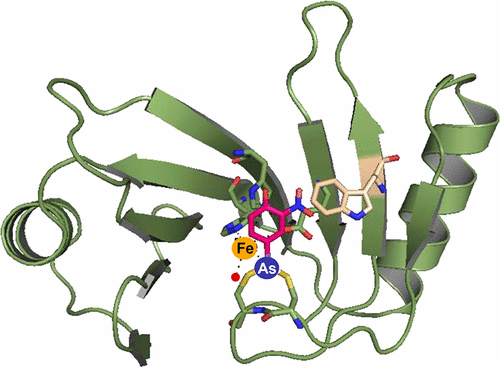当前位置:
X-MOL 学术
›
Environ. Sci. Technol.
›
论文详情
Our official English website, www.x-mol.net, welcomes your
feedback! (Note: you will need to create a separate account there.)
Biochemical Characterization of ArsI: A Novel C–As Lyase for Degradation of Environmental Organoarsenicals
Environmental Science & Technology ( IF 10.8 ) Pub Date : 2017-09-22 00:00:00 , DOI: 10.1021/acs.est.7b03180 Shashank S. Pawitwar 1 , Venkadesh S. Nadar 1 , Ashoka Kandegedara 2 , Timothy L. Stemmler 2 , Barry P. Rosen 1 , Masafumi Yoshinaga 1
Environmental Science & Technology ( IF 10.8 ) Pub Date : 2017-09-22 00:00:00 , DOI: 10.1021/acs.est.7b03180 Shashank S. Pawitwar 1 , Venkadesh S. Nadar 1 , Ashoka Kandegedara 2 , Timothy L. Stemmler 2 , Barry P. Rosen 1 , Masafumi Yoshinaga 1
Affiliation

|
Organoarsenicals such as the methylarsenical methylarsenate (MAs(V)) and aromatic arsenicals including roxarsone (4-hydroxy-3-nitrobenzenearsenate or Rox(V)) have been extensively used as an herbicide and growth enhancers in animal husbandry, respectively. They undergo environmental degradation to more toxic inorganic arsenite (As(III)) that contaminates crops and drinking water. We previously identified a bacterial gene (arsI) responsible for aerobic demethylation of methylarsenite (MAs(III)). The gene product, ArsI, is an Fe(II)-dependent extradiol dioxygenase that cleaves the carbon–arsenic (C–As) bond in MAs(III) and in trivalent aromatic arsenicals. The objective of this study was to elucidate the ArsI mechanism. Using isothermal titration calorimetry, we determined the dissociation constants and ligand-to-protein stoichiometry of ArsI for Fe(II), MAs(III), and aromatic phenylarsenite. Using a combination of methods including chemical modification, site-directed mutagenesis, and fluorescent spectroscopy, we demonstrated that amino acid residues predicted to participate in Fe(II)-binding (His5–His62–Glu115) and substrate binding (Cys96–Cys97) are involved in catalysis. Finally, the products of Rox(III) degradation were identified as As(III) and 2-nitrohydroquinone, demonstrating that ArsI is a dioxygenase that incorporates one oxygen atom from dioxygen into the carbon and the other to the arsenic to catalyze cleavage of the C–As bond. These results augment our understanding of the mechanism of this novel C–As lyase.
中文翻译:

ArsI的生化特性:一种新型的C–As裂解酶,用于降解环境有机砷。
甲基砷酸甲酯(MAs(V))等有机砷和包括roxarsone(4-羟基-3-硝基苯砷酸根或Rox(V))的芳族砷化物已分别广泛用作畜牧业中的除草剂和生长促进剂。它们经历环境降解,变成毒性更强的无机亚砷酸盐(As(III)),污染了农作物和饮用水。我们之前已经鉴定出一种细菌基因(arsI)负责亚砷酸(MAs(III))的好氧脱甲基。基因产物ArsI是Fe(II)依赖性的二醇外加氧合酶,可裂解MAs(III)和三价芳族砷化物中的碳-砷(C-As)键。这项研究的目的是阐明ArsI机制。使用等温滴定量热法,我们确定了ArsI对Fe(II),MAs(III)和芳族苯基亚砷酸盐的解离常数和配体对蛋白质的化学计量。使用化学修饰,定点诱变和荧光光谱等方法的组合,我们证明了预计会参与Fe(II)结合(His5–His62–Glu115)和底物结合(Cys96–Cys97)的氨基酸残基是参与催化。最后,将Rox(III)降解的产物鉴定为As(III)和2-硝基氢醌,证明ArsI是一种双加氧酶,它会将一个双氧原子中的一个氧原子掺入碳中,将另一个氧原子掺入砷中,从而催化C-As键的裂解。这些结果加深了我们对这种新型CAs裂解酶机理的理解。
更新日期:2017-09-22
中文翻译:

ArsI的生化特性:一种新型的C–As裂解酶,用于降解环境有机砷。
甲基砷酸甲酯(MAs(V))等有机砷和包括roxarsone(4-羟基-3-硝基苯砷酸根或Rox(V))的芳族砷化物已分别广泛用作畜牧业中的除草剂和生长促进剂。它们经历环境降解,变成毒性更强的无机亚砷酸盐(As(III)),污染了农作物和饮用水。我们之前已经鉴定出一种细菌基因(arsI)负责亚砷酸(MAs(III))的好氧脱甲基。基因产物ArsI是Fe(II)依赖性的二醇外加氧合酶,可裂解MAs(III)和三价芳族砷化物中的碳-砷(C-As)键。这项研究的目的是阐明ArsI机制。使用等温滴定量热法,我们确定了ArsI对Fe(II),MAs(III)和芳族苯基亚砷酸盐的解离常数和配体对蛋白质的化学计量。使用化学修饰,定点诱变和荧光光谱等方法的组合,我们证明了预计会参与Fe(II)结合(His5–His62–Glu115)和底物结合(Cys96–Cys97)的氨基酸残基是参与催化。最后,将Rox(III)降解的产物鉴定为As(III)和2-硝基氢醌,证明ArsI是一种双加氧酶,它会将一个双氧原子中的一个氧原子掺入碳中,将另一个氧原子掺入砷中,从而催化C-As键的裂解。这些结果加深了我们对这种新型CAs裂解酶机理的理解。











































 京公网安备 11010802027423号
京公网安备 11010802027423号